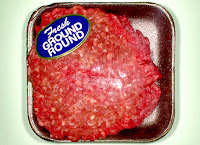 |
| Bison |
 |
| Cow |
The average US citizen consumes about 67 pounds of beef every year. That is a huge amount of beef which is most likely not grass fed, but rather corn fed and full of antibiotics and hormones. The problem that the US has is simply supply and demand. The beef industry cannot keep pace with the demand of beef in the US so manufacturers (I won't call them farmers) have decided to feed their cattle corn in order to make them bigger within a shorter period of time. Obviously corn is not a natural and organic source of food in a cattle's diet, so their bodies react differently when compared to eating natural grass. Since corn is not a natural dietary source of their diets, the cattle become larger and almost deformed when compared to normal grass-fed cattle. By altering the cattle, disease is increased and manufacturers also inject hormones and antibiotics to help with the growing process and make sure that the cattle don't become sick. This also adds a huge risks to human consumers because all of the hormones and antibiotics that is injected into the cattle is transmitted into the human consuming the meat. Corn-fed cattle are also confined in small spaces because there isn't enough room for the massive supply of cattle needed for consumers. Since they are not allowed to roam and eat natural diets they are reduced to confined spaces and are forced to stand in their own filth. All of that filth and sewage is transferred to the final meat product and thus, you.
 |
| Beware of Recalled Meats |
Every few months or so their is a massive recall of tainted beef and those are the only recalls we hear about, there are probably many more that the FDA and the government keeps under the sheets. You may be asking why would they do that but the meat industry is big bucks, so it wouldn't surprise me in the least. There is a solution to this mass productive debacle, you can buy grass-fed beef, but grass-fed beef is expensive and difficult to find. The problem is the government funds these big business corn-fed beef "farms", and thus, it's even more of a challenge to find grass-fed and natural beef. The best solution that I can present is instead of buying beef, buy bison meat. Bison is more reasonable in price compared to grass-fed beef and it's also a game meat, which means it's naturally lower in fat and low in calories. Bison meat is easy to find and purchase, and it's becoming more and more popular in the United States. Bison is more tender and since it's so lean, you won't feel guilty about having a burger (and it even tastes much better than a dry beef burger). Bison burger has less total fat than most meat products including pork, chicken and most fish. Bison also contains more iron than most meat products. Here is a brief nutritional statistic of a typical 3 oz. serving of
bison meat:
- Calories 152, Total Fat 7 grams (3 grams saturated fat)
- Excellent protein with 40 grams, which is 84% of the daily value (DV) in a 2,000-calorie diet.
- 60 milligrams of cholesterol or 20% of the daily value.
- Ground bison is high in vitamin B6 17% DV, B12 35% DV, iron 15% DV, and niacin 25% DV
- Sources: Bisoncentral.com, Nutritiondata.com
Regular ground beef:
- Calories 230, Total Fat 15 grams (6 grams saturated fat)
- 75 milligrams or 25% of the daily value of cholesterol
- Source: Nutritiondata.com
By consuming and purchasing bison meat or grass-fed beef, you can promote the organic and natural farmers in the US and this also promotes and helps the environment because if cattle and bison are allowed to live in open pastures and not in confined spaces, then other elements of the environment can strive and prosper. So by eating bison or grass-fed beef you can be both eco-friendly and nutritionally sound.






Maybe I'll give bison a try. I would never eat ground beef...way to risky and tastes terrible. Nutritional facts for bison are impressive.
ReplyDelete